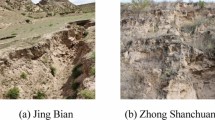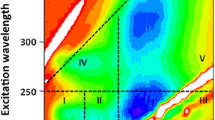Abstract
The stabilization potential of negatively charged sodium carboxymethyl cellulose (CMC) solution was assessed through investigation of its retention on clays under environmental conditions that promote soil desiccation. Sodium montmorillonite and kaolinite, commonly used in clayey soils, were mixed with aqueous CMC solutions in concentrations ranging from 0 to 10 g/L. These samples were dried in a specially-designed desiccation chamber which was operated at a temperature of 25°C and relative humidity of 30%. The results show an inverse proportionality between liquid loss and CMC concentration. Liquid loss from clayey soil follows the first-order reaction with a rate constant in the range of 4.6–6.7 mg/h. CMC half-lives on sodium montmorillonite during desiccation ranged from 103 to 181 h for an aqueous concentration range of 0.5–10 g/L compared to 108 h for distilled water. For kaolinite, more liquid was retained at 10 g/L CMC concentration than at other concentrations, but liquid retention was generally insignificant. These conclusions are valid for a desiccation duration of 890 h, a time that is reasonably simulative of the duration of exposures of bare ground surfaces to weather elements. The experimental results are explained in terms of the role of CMC molecular interactions with clay minerals in controlling fluid flow to desiccating clay surfaces.








Similar content being viewed by others
References
Bae S, Inyang HI (2006) Confirmation of aqueous polymer sorption in contaminant barrier clay using TGA measurements. J Mater Civ Eng 18:307–310
Ben-Hur M, Malik M, Letey J, Mingelgrin U (1992) Adsorption of polymers on clays as affected by clay charge and structure, polymer properties, and water quality. Soil Sci 153:340–356
Daniels JL, Inyang HI (2004) Contaminant barrier material textural response to interaction with aqueous polymers. J Mater Civ Eng 16:265–275
Fisher RA (1923) Some factors affecting the evaporation of water from soil. J Agric Sci 13:121–143
Greankoplis CJ (1993) Drying of process materials. In: Transport processes and unit operations. PTR Prentice-Hall, New Jersey, pp 532–540
Inyang HI, Bae S (2004) Estimation of polyethylene oxide polymer train and loop densities on contaminant barrier materials. J Environ Eng 130:806–905
Inyang HI, Bae S (2005) Polyacrylamide sorption opportunity on interlayer and external pore surfaces of contaminant barrier clays. Chemosphere 58:19–31
Inyang HI, Bae S, Fodor A (2010) Polymer solution-clay interaction effects on contaminant barrier material integrity: part II—damage parameters. Environ Eng Sci 27:623–632
Inyang HI, Fodor A, Bae S, Mbamalu G (2009) Polymer solution–clay interaction effects on contaminant barrier material integrity: part I: solution characteristics. Environ Eng Sci 26:1541–1550
Liu J, Shi B, Jiang H, Bae S, Huang H (2009) Improvement of water-stability of clay aggregates admixed with aqueous polymer soil stabilizers. Catena 77:175–179
Mitchell JK, Soga K (2005) Fundamentals of soil behavior, 3rd edn. Wiley, New Jersey
Parfitt RL, Greenland DJ (1970) The adsorption of poly(ethylene glycols) on clay minerals. Clay Miner 8:305–315
Theng BKG (1982) Clay polymer interactions: summary and perspectives. Clays Miner 30:1–10
Van Benschoten JE, Matsumoto MR (1997) Evaluation and analysis of soil washing for seven lead contaminated soils. J Environ Eng 123:217–224
Acknowledgments
This work was supported by a research grant from Seoul Women’s University (2010).
Author information
Authors and Affiliations
Corresponding author
Rights and permissions
About this article
Cite this article
Inyang, H.I., Bae, S., Lee, JY. et al. Desiccation of contaminant barrier materials amended with aqueous carboxymethyl cellulose solution. J Mater Cycles Waste Manag 14, 19–26 (2012). https://doi.org/10.1007/s10163-011-0038-5
Received:
Accepted:
Published:
Issue Date:
DOI: https://doi.org/10.1007/s10163-011-0038-5




